"Freedom or death"
Che Guevara
"Freedom or death"
After the declaration of the war to Batista, Fidel became involved in organizing resistance. In the last years of his stay at the university, Fidel already formed a circle of like-minded people who are ready to support him with his work. The group began to pull up young employees, workers, peasants.
Gradually, the military core of the leadership of the resistance. It includes Fidel's brother Raul, General Motors employee of the local branch of Jesús Montana, Pontiac’s employee Abel Santamaría, Pedro Miret, José Luis Tasenda and Renato Guitart Rosell. Engineering student and amateur weapons Pedro Miret led the rifle training squad. Great attention was paid to the conspiracy, the group was divided into dozens, whose members knew only their commander. All assigned pseudonyms. As a result, the case was kept secret. Work in the detachment was carried out in two directions: 1) increasing the political training of members and 2) developing the skills of handling small arms (the shooting range was made in the basement of the university).
The big problem was the financing of the operation, the purchase of weapons and ammunition. Young people literally sold off their property, gave away the last meager savings in order to scrape money for weapons. With great difficulty, they raised money to buy weapons for 165 people who were selected to storm one of the military facilities. Although the underground was significantly more people ready to oppose the Batista regime. In order not to be illuminated when buying weapons, we bought hunting rifles, small-caliber rifles, the sale of which was completely free in stores. This weapon was not necessary to register. Through one of the participants of the movement, who was a soldier and served in the military camp “Columbia”, about a hundred sets of soldiers and sergeants were procured. It was an easy task, as soldiers often sold uniforms to the peasants (they used strong clothing in agricultural work).
The underground decided to take by storm the barracks of Moncada - military barracks in the city of Santiago de Cuba, named after General Guillermo Moncada (the hero of the Cuban war of independence). The regiment of the regular army and cavalry squadron were stationed there. Santiago is located about 8 km from the Cuban capital, and it was impossible to quickly transfer troops there. The fact that the city was covered by a half ring mountain range of the Sierra Maestra was taken into account. It was believed that success in Santiago would lead to a rebellion in the province of Oriente. To organize the base in the suburbs of Santiago, a small farm "Siboney" was acquired. They brought weapons, ammunition, equipment to it. Speech outlined on July 800. These days traditional carnivals took place in the city, which made it possible for a significant number of strangers to come to the city without causing questions. In addition, the combat capability of the military fell, many officers went to layoffs. Preparations for the attack was about a year.
The advance team had to remove the sentries at the gate and let the convoy inside the complex. The assault group commanders hoped to take the garrison by surprise and arrest sleeping soldiers without too much bloodshed. To maintain the progress of the main operation, two auxiliary detachments were allocated. The first detachment under the command of Abel Santamaría was to occupy the hospital building. The building was behind the barracks and allowed to control the rear of the enemy, besides the group had to ensure the reception of the wounded. The second detachment under the command of Raul Castro was to take the building of the Palace of Justice, which was adjacent to one of the sides of the barracks. The building was high and from it it was possible to fire at enemy firing points located on the roof of the barracks.
26 July operation began. At the very beginning of the operation, an overlay occurred, which destroyed the hope of success. The foot patrol, who performed the external round, did not pay attention to the convoy of cars, but noticed something was wrong at the gate, where the sentries were filming. A firefight began, and inside the barracks they managed to raise the alarm. As a result, the operation was failed, such small forces could not take combat-ready garrison. The rebels took the fight in the most unfavorable conditions: there was no surprise, the enemy greatly outnumbered the number and weapons. However, at the beginning of the rebels saved the fact that the officers of the garrison were at a loss, not knowing what was happening and only fought back. But then the government forces launched a counterattack and surrounded the rebels. Realizing that the assault had failed, Fidel gave a signal for retreat. Raul Castro's group and the best arrows led by Pedro Miret covered the withdrawal of the main forces.
The assault team returned to the farm. Only a few dozen people remained, the rest died, hid or fled. Fidel decided to go to the mountains and start a partisan war. He was supported by 18 people. They went to the mountain range Gran Piedra. As it turned out, they made the right choice and almost all saved their lives. Those who remained fell under the flywheel of terror and were brutally murdered. The authorities organized a real hunt for the participants in the uprising, tortured many before they killed.
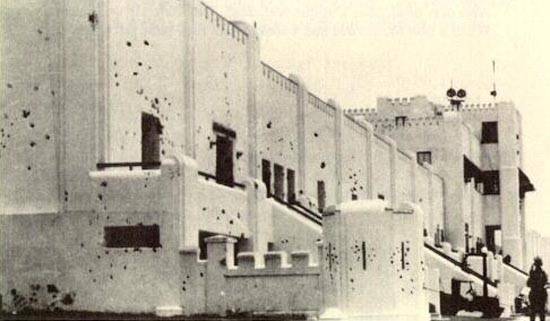
The barracks of Moncada immediately after the attack of the revolutionaries
29 July arrested Raul Castro. 1 August military patrol detained Fidel's group. The rebels were lucky, they were detained by Lieutenant Pedro Sarria, who had a fair character. He did not allow the soldiers, and then other military on the way to kill the rebels on the spot. Sarrià also took the rebels to a civilian prison, not to Moncada, where they would be killed immediately. The fact of the transfer of Fidel to the justice authorities was officially registered.
21 September trial began, it was held in the building of the Palace of Justice, in Santiago. 30 stormed the participants before the court. Fidel Castro prepared the materials and defended himself. The authorities were annoyed that Fidel was protecting himself. Under the pretext of Fidel's illness, although he was healthy, his case was singled out into separate legal proceedings. At the general process, he no longer appeared. October 16 1953, Fidel Castro delivered his speech, which became known to the world as “History I will be acquitted ”:“ As for me, I know that prison will be a difficult test for me, which I have never been to anyone else. It is full of threats for me, low and cowardly cruelty. But I am not afraid of prison, just as I am not afraid of the rage of the despicable tyrant who took the life of my 70 brothers! Make your sentence! It does not matter! History will justify me! ”
She became one of the most brilliant examples of revolutionary oratory. Fidel received an 15 year sentence, Raul and three more rebels were sentenced to 13 years in prison, 20 people were 10 years old, and so on. In May, 1955 and his comrades, under public pressure, were released under a general amnesty, served for the organization of the armed rebellion for about 22 months. In the same year, first Raul and then Fidel Castro emigrated to Mexico, as they could be physically eliminated.
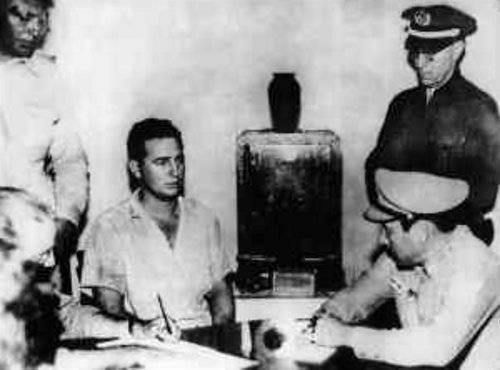
Fidel in court
July 26 Movement
Still in conclusion, it was decided to create the “July 26 Movement”, which will continue the fight against the Batista regime. The base of the revolutionary movement decided to make Mexico. This country was considered at that time one of the most democratic in Latin America. She traditionally provided asylum to political refugees. Fidel hoped to assemble and prepare in Mexico a strike force to return to Cuba.
In Mexico City, revolutionaries settled in a house with a woman named Maria Antonia González Rodriguez, who had lived in emigration for several years. Maria Antonia recalled: “Fidel arrived with one suitcase full of books, he was holding another bundle of books under his arm. There was no other baggage. ” In July, 1955, Ernesto Che Guevara joined the revolutionary squad. He was enlisted as a doctor, since he was a medical doctor by training.
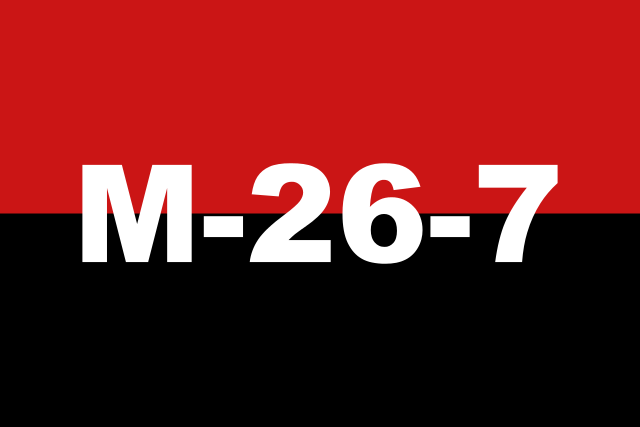
Movement Flag
8 August 1955, Fidel signed Manifesto No. 1 - the first political document addressed to the whole Cuban people. The document called on all honest Cubans to cooperate with the Movement, whose goal is the restoration of democracy and social justice in Cuba. The first requirement of the Movement was the prohibition of large land tenure (latifundia), the distribution of their land among the peasants who received them into inalienable property. Workers should have been eligible for most of the profits of all large industrial and commercial enterprises. It was proposed to industrialize the country on the basis of a single plan, nationalize those industries that serve the entire population (electricity, gas, telephone networks), drastically reduce the rent that took people up to a third of earnings, create ten children's camps in which they can learn and eat for free to 200 thou. children of workers and peasants. The state apparatus was proposed to reorganize in the interests of the people, and not narrow groups of wealthy citizens. All property of corrupt officials and embezzlers was subject to confiscation.
Gradually, the sympathies of most members of the orthodox party leaned toward the July 26 Movement. Volunteers arrived in Mexico, of them formed fighting groups, purchased weapons, ammunition and ammunition. Money for the Movement was collected from the world on a string. The former Colonel of the Spanish Republican Army Albert Bayo became a military professor. He had good training, knew partisan and anti-partisan methods of struggle, and organized training under the guise of English language courses. Gradually, this elderly man became so agitated that he refused payment, and became a revolutionary himself.
In October-December 1955, Fidel visited the United States and the Bahamas. He spoke to immigrants from Cuba, explaining the goals of the movement, with an analysis of the situation in Cuba. He gives a speech in New York in which he says: "In 1956, we will become either free or martyrs." In Nassau, Fidel Castro compiled the Manifesto No. 2 “26 Movement of July” to the Cuban people, where he asked people to help with money, how much they can: “Others ask money for themselves and give pledged houses, land, clothes, we ask money for Cuba, and as a pledge we give our lives. ” The influx of volunteers and money increased.
In the meantime, the situation in Cuba was heating up. Demonstrations against the Batista regime and student unrest have become commonplace. Batista suspended the constitutional guarantees in the country and tightened censorship. Military police patrolled the streets and conducted mass arrests of suspected insurgents. The intelligence services seized and tortured people. In April, 1956 was crushed by a military rebellion led by Ramon Barkin. Hundreds of officers were repressed, which weakened the army. By order of Batista, one of the “hot spots” of the opposition to his regime was temporarily closed - the University of Havana (reopened only after the 1959 revolution of the year).
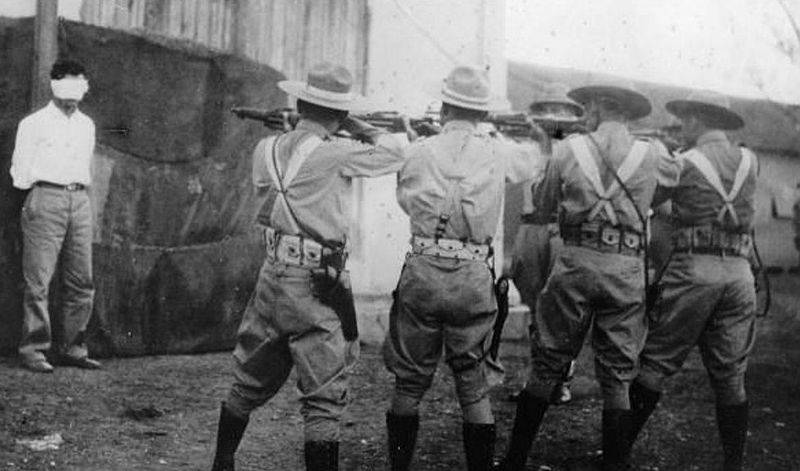
Batista soldiers shoot rebels in 1956 year
The revolutionaries considered that the auspicious moment had come and decided to return to their homeland. They bought the yacht "Granma" ("Granny"). An 82 man was selected for the expedition. People were gathered on the night of November 24 1956 of the year in Tuxpan. On the night of November 25 the yacht lifted the anchor. Granma was moving at a slower speed than revolutionaries had supposed. They planned to land on Cuba on November 30, an uprising on the island was scheduled for that day. There was no opportunity to warn comrades about the delay. Therefore, the uprising began as planned on November 30. Several hundred people, under the command of Frank Pais, launched an assault on important objects in Santiago de Cuba. After a few hours of battle, the military and the police were able to put down the uprising, arrests began.
On December 2, 1956, a detachment landed ashore near the village of Belik in the Los Colorados area of Oriente province. The revolutionaries were in a hurry, fearing the appearance of a patrol aviation or Navy ships, therefore, they landed in a swampy mangrove forest, not looking to find a more convenient place. The swamp was overcome with great difficulty. More than 5 hours of tremendous effort was required by the detachment to overcome 1,5 km of marshy thickets.
Guerilla wrestling
Because of the difficulties that the revolutionary squadron had experienced at the very beginning (being late with disembarking, having to throw some of the weapons and ammunition, food), the rebels refused to attack the town of Nikero and moved in the direction of the Sierra Maestra mountain range. December 5 exhausted detachment made a halt, poorly organized security camp. On the revolutionaries stumbled upon a company of soldiers, scouring the area. The rebels were taken by surprise, defeated and scattered.
But 12 man led by Castro made their way to the mountains of the Sierra Maestra. The guerrilla unit was able to conduct several successful operations. These were minor local successes, but they caused a great political, public response. The rank and file and part of the officers began to refuse to conduct operations in the mountains. The actions of the military and civilian authorities, who evacuated the population of the mountain areas in order to deprive the partisans of support, irritated the local peasants. 17 February 1957 of the Year Fidel Castro gave his first interview to the correspondent of the American newspaper The New York Times Herbert Matthews. February 24 newspaper gave the first article entitled "Visiting the Cuban rebel." She made a huge impression. All of Cuba learned that Fidel was alive and fighting (previously, false information about the death of a group of revolutionaries was spread).
The revolution began to gain momentum. Rallies, protests and disobedience were held throughout the country. Castro was able to communicate with the underground workers M-26, who operated in Santiago de Cuba and Havana. 13 March 1957, a revolutionary squad, mostly students, attacked the presidential palace in the hope of killing Batista. It was a suicide attack. Heroes made their way to the presidential office, but the dictator escaped. The remains of the rebel detachment retreated, in subsequent raids most of the young people were captured and executed. This heroic action caused a huge public response. At the same time, another group of young people from the “Revolutionary Directorate”, under the leadership of its General Secretary, José Antonio Echeverria, seized a radio station and called on the people to revolt. Almost all brave men died. Thus, the revolutionary movement embraced the entire progressive part of Cuban society. And the death of young heroes only strengthened the revolutionary mood.
Fidel's squad was still small - only a few dozen fighters. But he was able to win up over the Batista regime in the information field of the country. Correspondent Robert Taber with cameraman Wendell Hoffman made a film about the rebels. Cinema made a big impression on society. From now on, a real stream of journalists has gone who wanted to meet with Fidel. The revolutionaries began to beat up over the Batista regime in information terms, they were supported by the majority of the population of Cuba.
Then the process went on the rise. In July, the leader of the orthodox party, Raul Chibas, and the representative of the ousted President Batista Prio Socarras, Felipe Pasos, arrived to Fidel in July. 16 July 1957 was adopted by the Sierra Maestra Pact, which called for the unity of all progressive forces opposing the Batista regime.
The rebels won several victories, their ranks grew. On July 26, a new detachment was formed - Column No. 2, under the command of Che Guevara. September 5, 1957 representatives fleet and the July 26th Movement revolted in the city of Cienfuegos. The uprising was crushed, but it became obvious that the revolution was growing. Government troops no longer ventured into the mountains, blocking the rebel area. The government wanted to strangle the movement with hunger, but failed.
In the period 1957-1958. the rebels conducted dozens of small and several large operations. The Rebel Army was created. At the beginning of 1958, a partisan detachment led by Raul Castro made the transition to the Sierra del Cristal mountain range. A second front was opened. In the west, in Pinar del Rio, the rebels opened the Third Front. 24 May 1958, government forces attempted a general operation, gathering up to 14 thousands of soldiers. 11-21 July 1958, the battle took place at El-Higue, the partisans surrounded and forced the infantry battalion to surrender under the command of Major Quevedo. 28-30 July 1958, in the battle of Santo Domingo, rebels defeated large government forces. Thus, a strategic turnaround occurred in the war, the rebels began to win victories over large government forces.
At the end of the summer - in the autumn of 1958, the partisan army launched an offensive and began to win one after the other victories, to occupy settlements and areas. The army almost completely lost its fighting capacity, was demoralized, many military men went over to the side of the rebels. December 31 1958, Batista fled from Cuba. January 1 1959, the revolutionary forces entered Santiago, January 2 - in Havana. It was a complete victory. The Provisional Government was led by Manuel Urrutia (President), Miro Cardona (Prime Minister) and Fidel Castro (War Minister). In February, 1959, Fidel took over as head of government and got the opportunity to "turn the country to the ground."
17 in May 1959, the Cuban Council of Ministers passed a law on agrarian reform: in accordance with it, it was planned to withdraw land from more than 400 hectares from the owners and to divide them among the peasants. To protect the revolution, thousands of police were created. Then Fidel announced the nationalization of large enterprises and banks, mostly owned by Americans. Thus, gradually, Fidel embarked on the path of socialism. After trying to overthrow the revolutionary government of Cuba in the 1961 year (Operation in the Bay of Pigs), Fidel Castro officially announced that his country was on the socialist path of development.
Thus, Fidel did the impossible: with a handful of people he raised the people to fight. The colonial model of development was destroyed. The division of the population into a small stratum of "owners of life", which burned through life in beautiful hotels, casinos, brothels and the poor masses, was destroyed. In general, in Cuba, there was a real social revolution in the interests of the majority of the people.
Fidel and the USSR-Russia
The Cubans had a real friendship with the Russians, despite the fact that Fidel had ideological differences with the leadership of the post-Stalinist USSR. Khrushchev, after the end of the Caribbean crisis, he called “the son of a bitch”, he was wary of Brezhnev, he even looked at Gorbachev with undisguised contempt. But Fidel did not betray friendship.
“These people really learned what war and the tragedy of war are, that is why he loved the world more than anyone; but I can also say about this Russian people that it was the most disinterested people, ”said Fidel Castro. Russians and Cubans fought together for the victory of socialism in the countries of Latin America, Angola, Ethiopia, Mozambique and other countries. The Soviet people helped the Cubans build a peaceful life in Cuba. Fidel warmly welcomed the children of Chernobyl, who were invited to be treated in Cuba. Liberty Island became the most important strategic outpost of Soviet civilization in the Western Hemisphere.
In the USSR, Fidel himself was adored by ordinary people, feeling in him “his” person. Each arrival of the Cuban leader in the USSR was an event. One of his first visits to the USSR, Fidel Castro traveled through the entire Soviet country, from the Crimea to Siberia itself. And everywhere he was accepted as "his boyfriend." On the way to Bratsk, not far from Zima station, local workers stopped the Comandante train. They demanded that they show the father of the Cuban revolution, and cut off the Trans-Siberian Railway. Castro went to the workers in one light summer army uniform. The workers presented a Cuban with a padded jacket, and in response, Castro delivered a box of Cuban cigars to the workers. In general, in the entire history of Russia, it is obvious that we did not have a better ally and friend.
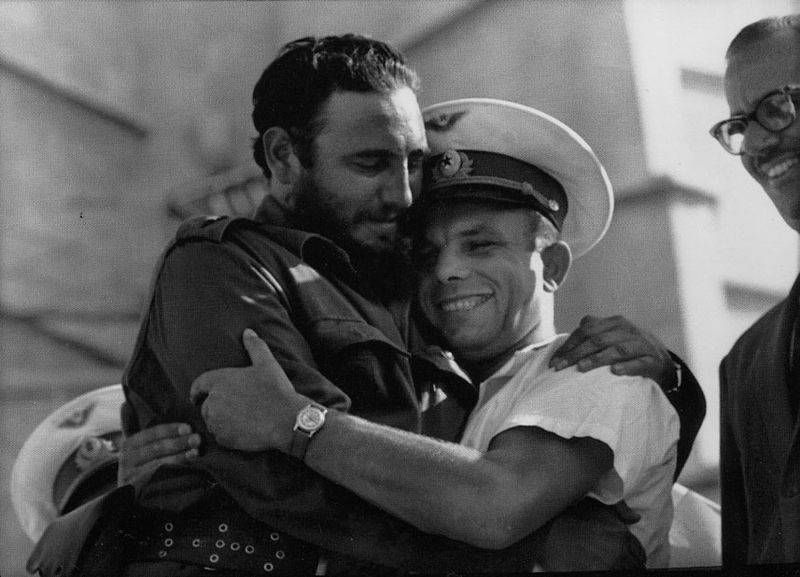
Fidel and Gagarin. 1961 year
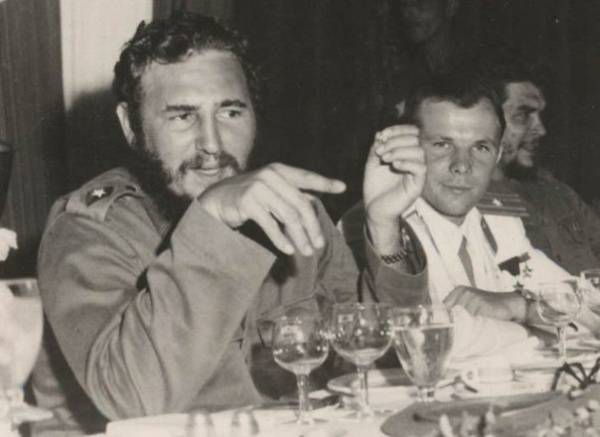
On a rare photo, Gagarin, Che Guevara and Fidel are sitting at the same table.
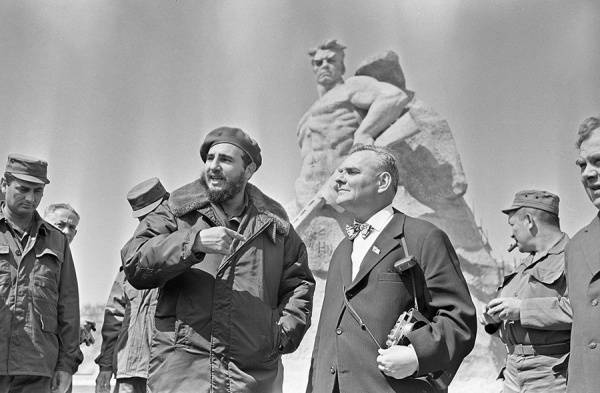
Fidel Castro and sculptor Yevgeny Vuchetich, author of the memorial to the heroes of the Battle of Stalingrad on Mamayev Kurgan
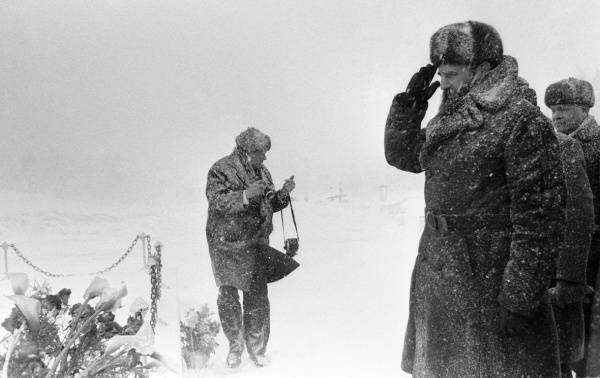
Fidel Castro at the monument to the defenders of Moscow
Significance of the cuban revolution
Fidel Castro has deservedly become one of the greatest figures of the 20th century and world history. First, he achieved the liberation of Cuba and the Cuban people from the colonial yoke of the United States, becoming one of the great leaders of the national liberation struggle. Cuba from the American semi-colony, “brothel and casino USA”, became one of the examples of successes of the socialist development path and a beacon of hope for many other countries. In particular, her example is the hope for the socialist development of all of Latin America.
Also, small Cuba has shown that a whole nation can resist such a giant as the USA (one more such example is Vietnam). Fidel retained socialist Cuba under conditions when socialism was destroyed in the Soviet Union.
Secondly, we see the image of a man who rose up against the whole system - a semi-colonial, corrupt and criminal regime, which was supported by the States, and won. Fidel proved that “there is one soldier in the field”. He advocated social justice and the people supported him. At the same time, Fidel did not bow his head even when Gorbachev and Yeltsin betrayed the socialist camp, including Cuba. Cuba during this period had to be very difficult, but it survived, proving to the whole world that the Island of Freedom is held not only by the multibillion-dollar assistance of the Soviet Union, as claimed by the Americans and other Westerners.
Thirdly, Fidel Castro showed the whole world that even in the conditions of limited resources of a relatively small island and an economic blockade of the USA, the socialist system can achieve serious success.
At the same time, the Westerners created the myth of "flourishing" under the capitalists of Cuba and the "communist hell" under Fidel Castro. It is replicated in Russia. Like, before the revolution, the country flourished, developed industry, agriculture, construction, trade and tourism. With free trade, shops were overwhelmed with goods. Beautiful houses and hotels were built, there were a lot of new cars, people dressed in European fashion, the “middle class” flourished. However, "revolutionaries mad at fat brought communist hell to the people of Cuba", a card system, poverty and isolation from the whole world. Supposedly the same thing happened in the USSR. And the example of Cuba shows that the communist revolution is a dead end, beyond which complete degradation. In general, this is a semblance of myths about “prosperous” Tsarist Russia, which “we have lost” because of the “damned Bolsheviks”.
However, in the same US were forced recognizethat in poor Cuba, the health care system is better than in the rich States. WHO, comparing healthcare expenditures per capita per year and average life expectancy, respectively, gave the following figures: in the USA - 9403 US dollars and 78,1 year, in Cuba - 817 and 76 (according to American sources even more - 78 years). Thus, poor Cubans live as much as rich Americans. This fundamentally refutes the famous thesis of the sociologist Samuel Preston, who proved the direct relationship between income and life expectancy. According to his research, people born in richer countries have a longer age than those born in poorer countries.
In 2014, World Health Organization director Margaret Chan put Cuban health care in first place among the countries of the Americas on the “fair funding mechanism”. In Cuba, the Constitution effectively guarantees free medical care as a basic human right.
When the truth began to make its way into the Western media, it was a big surprise for the inhabitants of the Western world. Prior to that, the stories of Cuban émigrés, who told of Fidel’s Republic as hell on earth or said that quality care was available only to the communist elite, were taken for “truth.” The scandalous hour and a half film Healthcare by the famous American documentary director Michael Moore (the author of Fahrenheit 2007 / 9) about the imperfection of the US medical insurance system was a real shock in 11 for citizens of the “great United States”. As a counterbalance to the inhuman American medical aid, only for money and only for insurance, Moore gave examples from Cuban practice.
The director, of course, was accused of lying in the propaganda of socialism, they say, "this can not be by definition." As a result, Senator Tom Harkin, chairman of the committee on health care, education, labor and pensions, went to Cuba and spent three days on Liberty Island. Upon return, he revealed the CIA’s Cuban medical record: “In 2013, the infant mortality rate in Cuba is the 4,76 case for live-born 1000, compared to the US 5,90,” Harkin said. Next: in Cuba, 6 deaths before 5 are recorded on 1000 born alive in the period from 2005 to 2010 a year, and again the score is not in favor of the USA with 8 deaths. Estimated life expectancy for both genders in 2013 in the United States was 78,62, while in Cuba it was 78,05. ” And according to the Pan American Health Organization, according to experts of the mission working in Cuba in 2012, the average life expectancy in Cuba was 79,2.
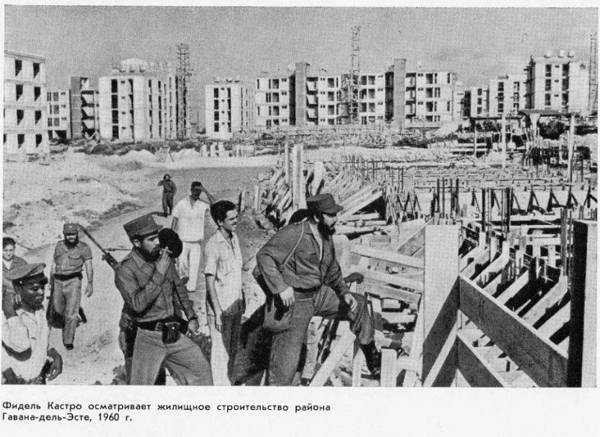
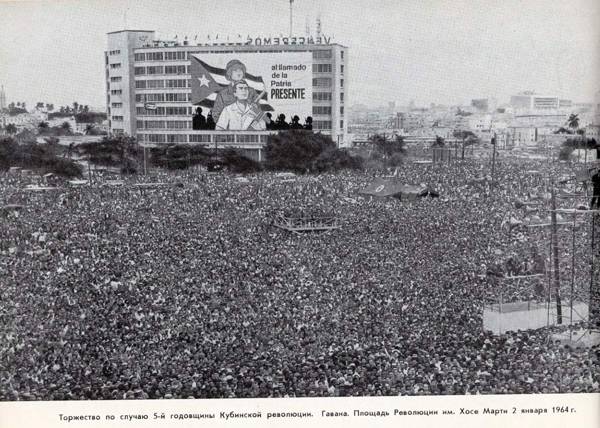
Thus, Cuba is a real example of a country of a healthy lifestyle and the highest level of health care for all, not just the elect. In the West, medicine is a long-standing system where maximizing profits is a kind of religion.
Among other examples of the success of the socialist system in Cuba (we recall, in the conditions of a severe lack of resources and a long blockade), we can also note the creation of powerful free education systems and social protection of the population. 1961 launched a nationwide campaign to eradicate illiteracy. Slum areas, where ordinary Cubans used to live (and now huge masses of the population live in all Latin American countries), were demolished, dozens of well-appointed urban areas were erected in Cuba, and they received running water, gas, and electricity. Cuba currently has one of the highest levels of life expectancy in the world. At the same time, Cuba actively helped other Latin American countries in the field of health care and education.
Thus, the departure of Fidel Castro is the departure of the last great leader of the 20th century. Titan, who challenged the masters of the West, defending social justice, and made a successful anti-colonial revolution.
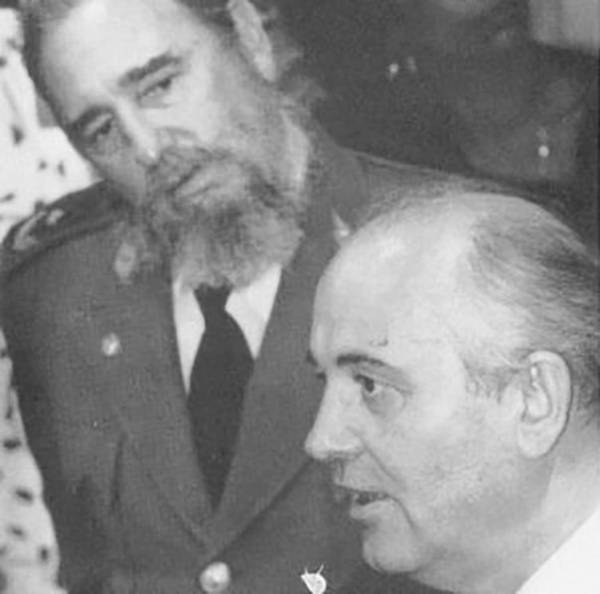
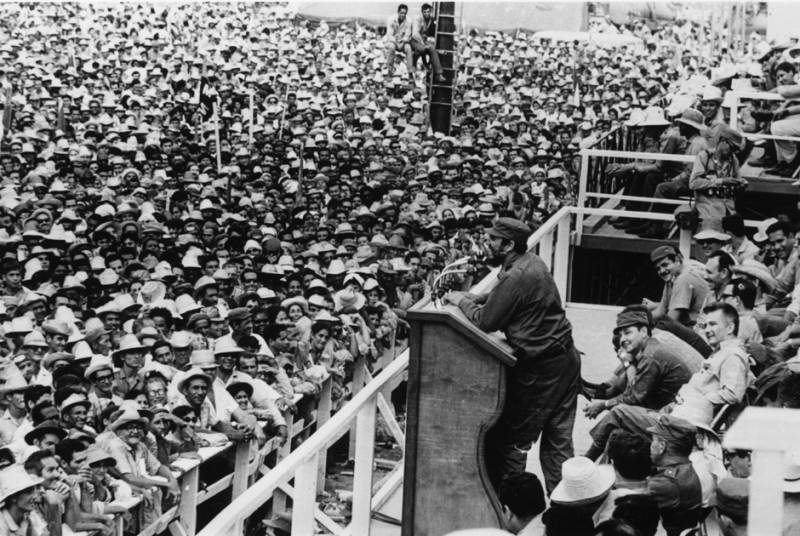
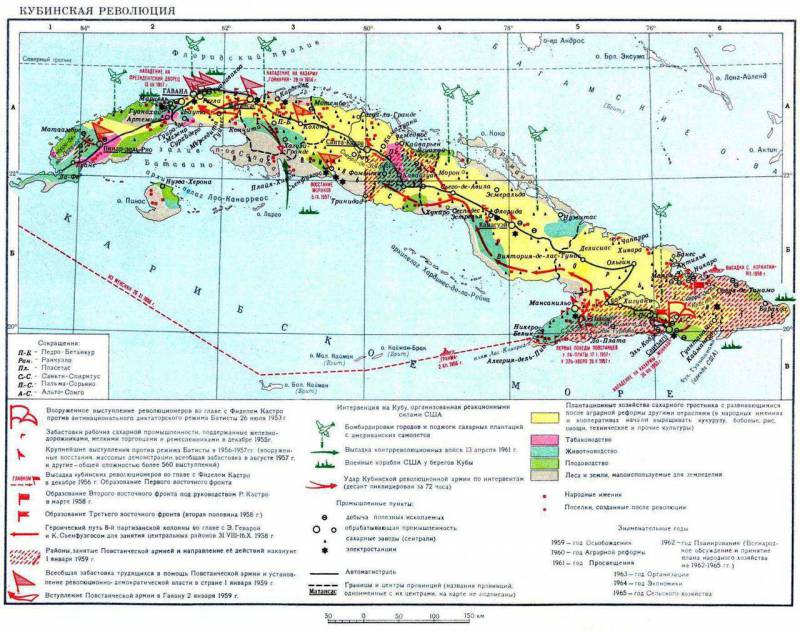
Information